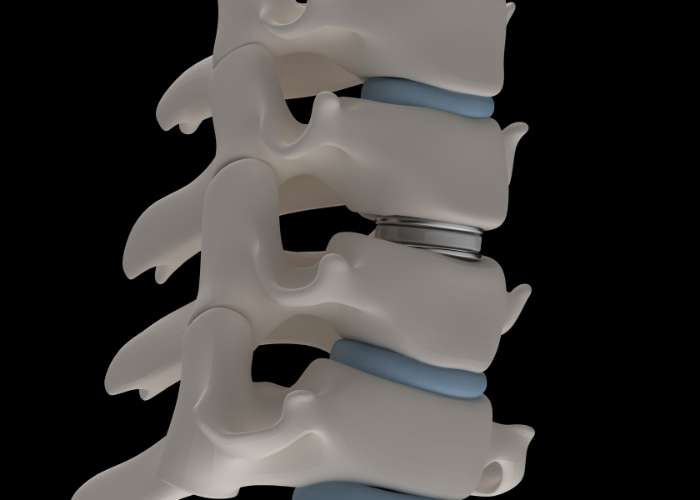What is an artificial disc?
Between the vertebrae of the spine are discs, which cushion the bones and prevent them from rubbing on each other while helping the spine move. An artificial disc replaces a natural disc that has degenerated, allowing cushioning, mobility, and flexibility.
What is an artificial disc made of?
There are several different types of discs that can be used in spinal neurosurgery. In general, most discs are made of a metal outer shell, such as cobalt chromium, stainless steel, or titanium, with a flexible medical-grade plastic (polyethylene) inside. The disc allows for articular motion and load bearing. The job of an artificial disc is to replace the damaged disc while minimizing fatigue or fracture, friction and must have superior wear characteristics while minimizing the generation of wear debris.

What is cervical artificial disc replacement?
While the body has several joints that can be replaced if they wear out, such as the shoulder, knee, or hip; the neck and back do not have that luxury. Cervical artificial disc replacement is a type of joint replacement that involves removing the damaged disc and inserting a cervical artificial disc into the intervertebral space. The prosthetic device is designed to maintain motion and flexibility in the treated segment of the vertebra. Cervical artificial disc replacement surgeon, Doctor Brenton Pennicooke treats patients in in Saint Louis, Creve Coeur, and surrounding cities in St. Louis County, Missouri who would benefit from having a cervical disc replacement.
Are cervical artificial discs FDA-approved?
Dr. Pennicooke only uses FDA certified and approved artificial discs. It is essential to talk to a neurosurgeon who has experience with this delicate surgery and who uses only FDA-approved devices.
Does insurance pay for a cervical artificial disc replacement?
The short answer is; it depends on your insurance. If the patient qualifies, according to their own insurance’s guidelines, the procedure is often covered. Medicare does not currently cover cervical artificial disc replacement. If you have a question about insurance coverage or need help determining your own coverage availability, please contact our office: We are happy to help!
Why would I need cervical artificial disc replacement?
The cervical spine is made up of 7 vertebrae, cushioned by discs that lie between each vertebra. The discs act as shock absorbers and allow the neck to move. This structure also forms a protective tunnel for the spinal cord and nerves that supply the body with sensation and movement. Over time, the discs can wear down, causing the vertebrae or the disc to press on the spinal nerves or the spinal cord. This can cause pain, weakness, numbness and tingling, often in the arms or hands. When these symptoms are not alleviated by non-surgical methods, a cervical artificial disc replacement may offer the advantage of allowing more movement and creating less stress on the remaining vertebrae than with traditional cervical disc surgery.
How is cervical artificial disc replacement done?
Dr. Pennicooke does cervical artificial disc replacement with general anesthesia. A small incision is made either in the front of the neck, or the side, depending on the best area for the patient and the specific disc that needs to be replaced. The exact surgical procedure will vary slightly, depending on the patient, but in general patients can expect the following:
- Once under anesthesia and the first incision has been made, the soft tissues of the neck are moved aside so Dr. Pennicooke can gain access to the spine.
- He will remove any disc fragments, bone spurs or other structures that are pressing against the nerves or spinal cord.
- The damaged disc is removed.
- If necessary, bone may be removed to allow for decompression (taking the pressure off of the spinal cord and/or nerves).
- The artificial disc is secured into place using specialized instruments.
- The soft tissues are carefully moved back into place.
- The incision is closed.
How long is the recovery after disc replacement surgery?
Dr. Pennicooke will have a specific post-surgical treatment plan based on the individual patient. In general, patients will wear a cervical collar for support while the neck heals. Physical therapy can be started, as directed, 1-2 weeks after surgery, depending on how quickly the patient heals. Full recovery after cervical disc replacement surgery usually takes 4-6 weeks.
Cervical Artificial Disc Surgeon

If you have a worn disc in your neck that is pressing on your spinal cord, this can cause numbness, weakness, tingling in the arms and legs, and extreme pain. Cervical artificial disc replacement is a type of joint replacement that involves removing the damaged disc that is causing problems and inserting a cervical artificial disc into the intervertebral space. Doctor Brenton Pennicooke, provides diagnosis as well as surgical treatment options for patients in Saint Louis, Creve Coeur, and surrounding cities in St. Louis County, Missouri who are in need of a cervical artificial disc replacement. Contact Dr. Pennicooke’s team today!